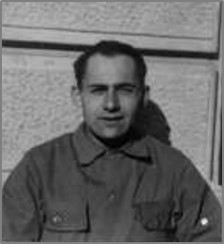Thomas Danek: Life and Death – by Benjamin Goldring
Editor’s note: At the initiative of ALBA board member Chris Brooks, who maintains the online biographical database of US volunteers in Spain, the ALBA blog will be regularly posting interesting articles from historical issues of The Volunteer, annotated by Chris. The return home from Spain was difficult for many volunteers. Benjamin Goldring recounts Canadian volunteer Thomas Danek’s extraordinary military career and his descent into desperation upon the conclusion of World War Two.
Thomas Danek: Life and Death
Benjamin Goldring
[Originally published in The Volunteer, Volume 7, Number 1, March 1985.]
Our lives take many turns. There can be passage, back and forth, from one social strata to another. I have heard it said that banditry is the unorganized war of the poor against the rich. It is a faulty generalization, with a kernel of truth. Faulty, because banditry is most often an attack of the poor upon the poor; truthful in so far as it takes note of a desperate thrashing about, a rebellion, against acquiescence to the subjugations which are the companions of impoverishment.
On Dec. 4, 1951, Thomas Danek, 34 years old, Spanish vet, commando in World War 2, was killed as he staged a hold up in a Toronto drugstore. The constable who shot him had been hidden in the partitioned off rear of the store. Thirty years later, I learned of Tom’s death.
Tom was a Canadian of Ukrainian descent, born in Winnipeg and raised in Windsor. He fought with the Washington and Lincoln Battalions. At the beginning of the Brunete offensive, he, I and Al Ragner were battalion runners; after Mesquite Ridge, the three of us were transferred into the decimated 3rd company; Danek was wounded, but came back in time for Quinto and Belchite. I remember the three of us together again in the 1st Company at Teruel.
My last memory of Tom is of his return from the hospital after having been hit in the wrist at Segua de los Baños. He told us that the doctor had offered his hand, and Tom had grabbed it and squeezed it so hard the doctor had to beg him to let go. From the shape of Tom’s hand, I thought this discharge was a mistake. In an interview with the Windsor Star, Al Ragner said, “I knew him as a very courageous fighter… you could rely on him all the way, a truly great friend and soldier…”
When England declared war on Nazi Germany, Tom volunteered at once. He was enrolled in the Essex Scottish Regiment, Windsor, and was sent to England in 1940. The quiet interlude did not suit his temperament and he got into disciplinary problems. He volunteered for commando service and was in the cross channel Dieppe raid of August 1942. The Nazis captured him and he was a prisoner of war, until January 1945. The Windsor Star, Toronto Telegram of Dec. 6, 1951 interviewing Tom’s brothers as well as some of his World War 2 buddies, were told that “he made a dramatic break from Stalag 2D, and with others, made his way across Germany to safety behind Russian Lines.”
All his buddies were surprised by what had happened to him. “He was a good pal and I want to go to his funeral,” said one. “He was a first class fighting man,” said another. A non-com described him “as a bad egg with a good service record and strong Communist leanings.” All “were unanimous in paying tribute to his personal courage.”
When I got back from overseas after World War 2, I communicated with Tom, and in January 1946, he wrote me that he was taking an auto mechanics course. Later, he wrote that he was signing up for two years in the merchant marine. In Spain he had told me that he worked in the coal mines in Canada. His brother Walter, told reporters that Tom “had been brought up in a broken home and was given too much freedom of action.”
Tom was laid off from a Toronto radio factory in the summer of 1951. He started to hold up drug stores. The hold-up in which he was killed was apparently his fourth; the police had stake outs in a number of drug stores; they had noted the pattern.
Tom lies buried in Green Lawn Memorial Gardens; Garden P (last Supper) – Lot B – Section 641; R. R. No.1, Hwy, No. 3, Oldcastle, Ontario, NOR ILO, outskirts of Windsor.













